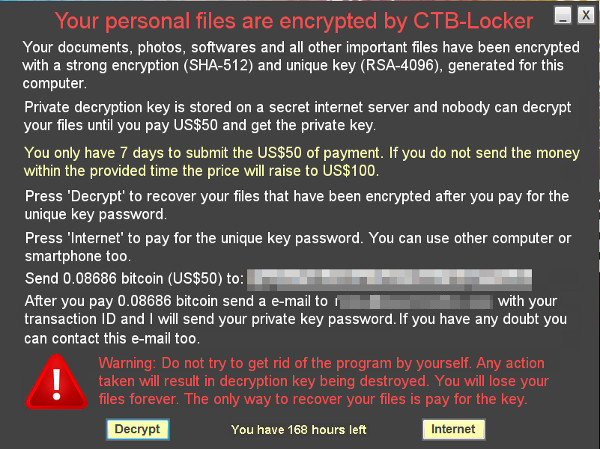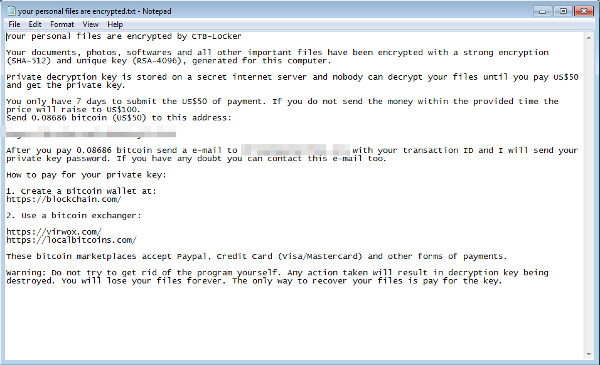RANSOM_ZIPTB.A
Trojan-Ransom.CTB-Faker (Ikarus), Trojan-Ransom.Win32.Blocker.jinn (Kaspersky), W32/Blocker.JINN!tr (Fortinet)
Windows


Threat Type: Trojan
Destructiveness: No
Encrypted: No
In the wild: Yes
OVERVIEW
Downloaded from the Internet, Dropped by other malware
This Trojan arrives on a system as a file dropped by other malware or as a file downloaded unknowingly by users when visiting malicious sites.
TECHNICAL DETAILS
EXE
No
12 Jul 2016
Encrypts files, Displays message/message boxes
Arrival Details
This Trojan arrives on a system as a file dropped by other malware or as a file downloaded unknowingly by users when visiting malicious sites.
Installation
This Trojan drops the following files:
- %ProgramData%\help.exe
- %ProgramData%\index.html - ransom note
- %ProgramData%\restore.exe - use for restoring the files from the ZIP archive file
- %ProgramData%\untitled.png
- %ProgramData%\your personal files are encrypted.txt - ransom note
- %System Root%\your personal files are encrypted.txt - ransom note
(Note: %ProgramData% is the Program Data folder, where it usually is C:\Program Files in Windows 2000, Windows Server 2003, and Windows XP (32- and 64-bit); C:\ProgramData in Windows Vista (32- and 64-bit), Windows 7 (32- and 64-bit), Windows 8 (32- and 64-bit), Windows 8.1 (32- and 64-bit), Windows Server 2008, and Windows Server 2012.. %System Root% is the Windows root folder, where it usually is C:\ on all Windows operating system versions.)
It drops and executes the following files:
- %ProgramData%\archiver.vbs
- %ProgramData%\archiver.bat - creates the password protected ZIP archive of files
- %ProgramData%\copy.vbs
- %ProgramData%\copy.bat
- %ProgramData%\startup.vbs
- %ProgramData%\startup.exe
- %ProgramData%\untitled.vbs - opens a fake message box about a graphic card error
(Note: %ProgramData% is the Program Data folder, where it usually is C:\Program Files in Windows 2000, Windows Server 2003, and Windows XP (32- and 64-bit); C:\ProgramData in Windows Vista (32- and 64-bit), Windows 7 (32- and 64-bit), Windows 8 (32- and 64-bit), Windows 8.1 (32- and 64-bit), Windows Server 2008, and Windows Server 2012.)
It drops the following non-malicious files:
- %ProgramData%\{bundled WinRAR package / components}
(Note: %ProgramData% is the Program Data folder, where it usually is C:\Program Files in Windows 2000, Windows Server 2003, and Windows XP (32- and 64-bit); C:\ProgramData in Windows Vista (32- and 64-bit), Windows 7 (32- and 64-bit), Windows 8 (32- and 64-bit), Windows 8.1 (32- and 64-bit), Windows Server 2008, and Windows Server 2012.)
Other System Modifications
This Trojan adds the following registry entries as part of its installation routine:
HKEY_CURRENT_USER\Software\Microsoft\
Windows\CurrentVersion\Run
help.exe = %ProgramData%\help.exe
Other Details
This Trojan encrypts files with the following extensions:
- .exe
- .msi
- .dll
- .jpg
- .jpeg
- .bmp
- .gif
- .png
- .psd
- .mp3
- .wav
- .mp4
- .avi
- .zip
- .rar
- .iso
- .7z
- .cab
- .dat
- .data
It does the following:
- The target files are located in %System Root%\Users.
- It moves the target files into a password protected archive, %System Root%\Users.zip.
- After encrypting files, it shuts down the system.
(Note: %System Root% is the Windows root folder, where it usually is C:\ on all Windows operating system versions.)
NOTES:
This Trojan displays the following:





SOLUTION
9.800
12.652.06
14 Jul 2016
12.653.00
15 Jul 2016
Step 1
Before doing any scans, Windows XP, Windows Vista, and Windows 7 users must disable System Restore to allow full scanning of their computers.
Step 2
Note that not all files, folders, and registry keys and entries are installed on your computer during this malware's/spyware's/grayware's execution. This may be due to incomplete installation or other operating system conditions. If you do not find the same files/folders/registry information, please proceed to the next step.
Step 3
Delete these registry values
Important: Editing the Windows Registry incorrectly can lead to irreversible system malfunction. Please do this only if you know how to or you can seek your system administrator’s help. You may also check out this Microsoft article first before modifying your computer's registry.
- In HKEY_CURRENT_USER\Software\Microsoft\Windows\CurrentVersion\Run
- help.exe = %ProgramData%\help.exe
- help.exe = %ProgramData%\help.exe
Step 4
Search and delete these files
- %ProgramData%\help.exe
- %ProgramData%\index.html
- %ProgramData%\restore.exe
- %ProgramData%\untitled.png
- %ProgramData%\your personal files are encrypted.txt
- %System Root%\your personal files are encrypted.txt
- %ProgramData%\archiver.vbs
- %ProgramData%\archiver.bat
- %ProgramData%\copy.vbs
- %ProgramData%\copy.bat
- %ProgramData%\startup.vbs
- %ProgramData%\startup.exe
- %ProgramData%\untitled.vbs
- %ProgramData%\{bundled WinRAR package / components}
Step 5
Scan your computer with your Trend Micro product to delete files detected as RANSOM_ZIPTB.A. If the detected files have already been cleaned, deleted, or quarantined by your Trend Micro product, no further step is required. You may opt to simply delete the quarantined files. Please check this Knowledge Base page for more information.
Did this description help? Tell us how we did.

